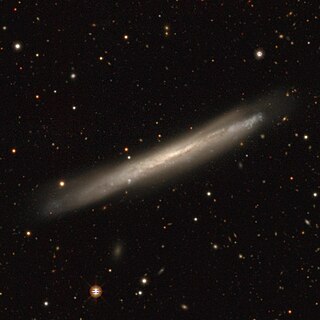Top Qs
Timeline
Chat
Perspective
NGC 3044
Galaxy in the constellation Sextans From Wikipedia, the free encyclopedia
Remove ads
NGC 3044 is a barred spiral galaxy in the equatorial constellation of Sextans. It was discovered on December 13, 1784, by German-born English astronomer William Herschel.[9][10] In 1888, Danish astronomer J. L. E. Dreyer described it as "very faint, very large, very much extended 122°".[11] It is located at an estimated distance of 67 million light years.[2] In the B band of the UBV photometric system, the galaxy spans 4.70′ by 0.80′[5] with the major axis aligned along a position angle of 113°.[7] It is a relatively isolated galaxy with no nearby companions.[7] R. B. Tully in 1988 assigned it as a member of the widely displaced Leo Cloud.[3]
The morphological classification of NGC 3044 is SBc,[6] indicating a barred spiral (SB) with somewhat loosely-wound spiral arms (c). It is being viewed edge-on, with a galactic plane that is inclined at an angle of 79°±4° to the plane of the sky.[12] The disk appears lob-sided and disturbed, suggesting a recent merger or interaction. There is a diffuse ionized gas extending to 1 kpc above the center of the plane.[7]
The stars in the galaxy have a combined mass of approximately 1.01×1010 M☉,[6] and the star formation rate is 2.77 M☉·yr–1.[6] The total mass of the atomic gas in this galaxy is 3.5×109 M☉,[7] and it has a dust mass of 1.6×108 M☉.[3] The galaxy as a whole has a dynamic mass of 6.4×1010 M☉.[7]
One supernova has been observed in NGC 3044: SN 1983E (type II, mag. 14)[13] was discovered by Natalʹja Metlova on 13 March 1983, at an offset 29″ east, 11″ south of the galaxy.[14][15][16]
Remove ads
References
Further reading
Wikiwand - on
Seamless Wikipedia browsing. On steroids.
Remove ads

